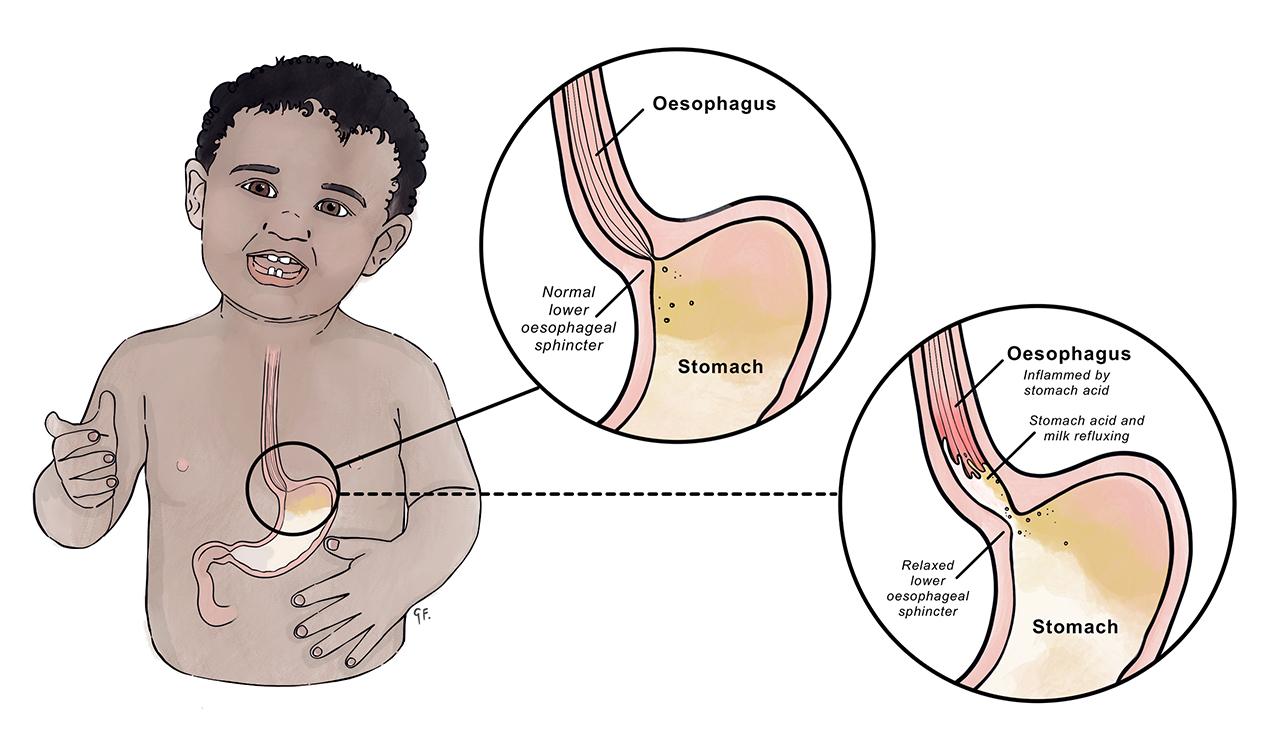What are the symptoms of Sandifer syndrome?
Sandifer syndrome is a condition that primarily affects infants and young children, characterized by a combination of gastroesophageal reflux disease (GERD) and abnormal movements or postures. Symptoms of Sandifer syndrome typically include:
- Abnormal Movements: The child may exhibit unusual movements or postures, such as twisting, arching of the back, or tilting of the head. These movements often occur in response to discomfort or pain.
- Arching of the Back: The child may arch their back, which can be a reaction to reflux or abdominal pain.
- Head Tilt: There may be a tendency for the child to tilt their head to one side, which can be associated with discomfort.
- Gastroesophageal Reflux: Symptoms of GERD, such as frequent vomiting, spitting up, and irritability after feeding, are common. The reflux can lead to pain and discomfort that triggers abnormal movements.
- Irritability: The child may be fussy or irritable, often due to discomfort from GERD.
- Feeding Difficulties: The child may have trouble feeding, which can be related to reflux or discomfort from the condition.
The abnormal movements and postures in Sandifer syndrome are thought to be a response to the pain or discomfort caused by GERD. Proper diagnosis and management of GERD are essential in alleviating the symptoms associated with Sandifer syndrome.
What are the causes of Sandifer syndrome?
Sandifer syndrome is associated with gastroesophageal reflux disease (GERD) and is characterized by abnormal movements or postures in response to reflux-related discomfort. The causes of Sandifer syndrome include:
- Gastroesophageal Reflux Disease (GERD): The primary cause of Sandifer syndrome is GERD, a condition where stomach acid frequently flows back into the esophagus, causing irritation and pain. This reflux can lead to discomfort that triggers abnormal movements or postures in response.
- Esophageal Irritation: The irritation and pain from acid reflux can provoke abnormal postures and movements as a way for the child to cope with the discomfort.
- Neurological Response: Although not a direct cause, the abnormal movements seen in Sandifer syndrome may be a neurological response to the pain or discomfort from GERD.
In essence, Sandifer syndrome is a manifestation of GERD-related discomfort that leads to characteristic abnormal movements or postures. Addressing the underlying GERD through appropriate treatment can often alleviate the symptoms of Sandifer syndrome.
What is the treatment for Sandifer syndrome?
The treatment for Sandifer syndrome focuses on managing the underlying gastroesophageal reflux disease (GERD) and alleviating the associated symptoms. Here are the main approaches to treatment:
- Medications for GERD: The primary treatment involves medications that reduce stomach acid and improve reflux symptoms. Common medications include:
- Proton Pump Inhibitors (PPIs): These drugs reduce the production of stomach acid, helping to heal the esophagus and reduce discomfort.
- H2-Receptor Antagonists: These medications also reduce stomach acid but are generally less potent than PPIs.
- Antacids: Over-the-counter antacids can help neutralize stomach acid and provide quick relief.
- Dietary Changes: Adjusting the child’s diet can help manage GERD symptoms. This may include:
- Smaller, More Frequent Meals: Feeding smaller amounts more frequently can reduce reflux.
- Avoiding Trigger Foods: Identifying and avoiding foods that exacerbate GERD symptoms can be beneficial.
- Feeding Adjustments: Modifications in feeding practices can help, such as:
- Thickening Feedings: Adding a thickening agent to formula or breast milk can reduce reflux.
- Holding the Child Upright: Keeping the child upright for 30 minutes after feeding can help reduce reflux.
- Positioning: Ensuring proper positioning during and after feeding can help manage symptoms. This may involve keeping the head elevated or avoiding lying flat.
- Surgery: In severe cases of GERD that do not respond to medical management, surgical options like fundoplication may be considered to prevent reflux.
- Monitoring and Follow-up: Regular follow-up with a healthcare provider to monitor the child’s response to treatment and make any necessary adjustments is important.
The goal of treatment is to reduce GERD symptoms, thereby alleviating the abnormal movements or postures associated with Sandifer syndrome.
Is Sandifer syndrome permanent or does it heal on its own?
Sandifer syndrome is typically not permanent and often resolves on its own, especially as the underlying cause—usually gastroesophageal reflux disease (GERD) or a hiatal hernia—is treated or as the child grows.
Key Points:
- Sandifer syndrome involves episodes of abnormal posturing, such as arching of the back and turning of the head, often associated with GERD.
- The condition is most common in infants and young children and is often mistaken for neurological issues, though it is primarily related to reflux.
Does it heal on its own?
- Yes, it often resolves as GERD improves, particularly as the child’s digestive system matures. Many children outgrow GERD by their first year or shortly after.
- Treatment of GERD: Managing reflux with medications, feeding changes, and positioning can help alleviate the symptoms of Sandifer syndrome.
In most cases, Sandifer syndrome is temporary, and once the underlying reflux or hiatal hernia is managed, the symptoms disappear. If GERD or the hernia is more severe, medical or surgical interventions might be necessary, but permanent neurological damage or ongoing issues from Sandifer syndrome are rare.

Leave a Reply
You must be logged in to post a comment.